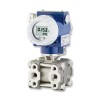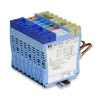Universal Serial Bus (USB) interface computer connection
The Universal Serial Bus (USB) interface is a popular digital interface for quick and easy connection of measurement devices to desktop & laptop computers and other digital measurement instrumentation.
A USB connection provides a global standard for the physical electrical connection, communication and powering of digital sensors and measurement instruments. A single cable is used for sending all the read & write commands, and providing a low dc supply voltage.
USB is a popular method for connecting measurement devices together in a research laboratory environment on experimental test rigs, where all test equipment is close by on the same test bench or rig.
The majority of USB measurement devices come with application software which can be installed on a laptop or desktop computer. USB provides the user with a plug & play set-up that can be up and running very quickly without the need for wiring, separate power supplies or signal conditioning instrumentation.
Glossary of Measurement Signal technical terms
- 2 Wire
- 3 Wire
- 4 to 20 mA Current Loop Output Signal
- 4 Wire
- Amplified Voltage Output
- BFSG – Bonded Foil Strain Gauge
- Deadband
- FSO – Full Scale Output
- HART®
- mV/V – Millivolts per Volt Output Signal
- NC – Normally Closed
- NO – Normally Open
- Piezoresistive Strain Gauges
- Ratiometric
- Span
- Span Offset
- Span Sensitivity
- Square Root Extraction
- Threshold
- Totalizer
- Transducer
- Transmitter
- TSL – Terminal Straight Line
- TSS – Thermal Span or Sensitivity Shift
- Turndown Ratio
- Vented Cable
- Wheatstone Bridge Strain Gauge
- Zero Offset
- Zero Tare
Help from Measurement Signal resources
- Supply voltage and load resistance considerations for pressure transmitters
- What can cause random variation in pressure transducer output
- What is the difference between zero offset and zero drift?
- Why use 4-20mA and 3-15 psi rather than 0-20mA & 0-15psi




